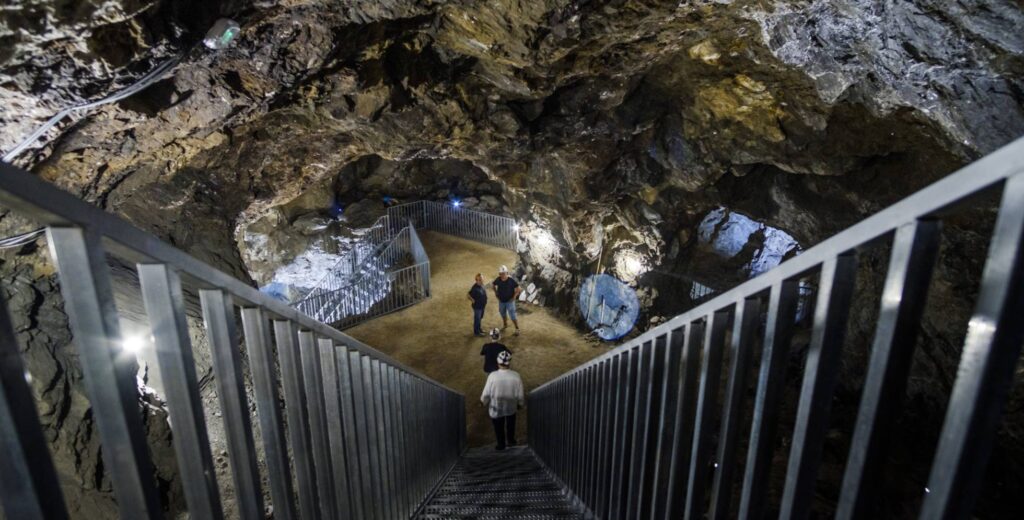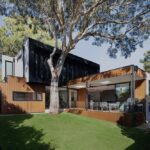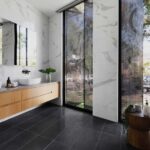Quick Geode Definition
In plain words, to understand what the Pulpí Geode is, or simply a geode, it is only necessary to imagine a hollow rock on the inside with its interior walls lined with pointed crystals. This definition may not be entirely approved by geologists and mineralogists, but it does get the point across effectively.
The hole in the rock, which ended up giving rise to this impressive Pulpí Geode, was produced by the filtration of water and mineral dissolution (karstification) and the flooding of volcanic hot springs for about 100,000 years that led to the union of the molecules that crystals slowly formed.
Importance of the Pulpí Geode
So now, why is the Pulpí Geode so important? First of all, because it is a very special mineral formation in the world due to several factors. One of them is that it is the second largest geode in the world (8 m long, 2 m wide and 2 m high) and the first to be visited without specific equipment. Another is due to the formation of huge and perfect transparent gypsum crystals that hold a very special treasure that makes them highly prized among collectors. This treasure is the precious celestine trapped at the base of the huge gypsum crystals, which measure almost 2 m.
Discovery, kept secrets and looting
The Geode was discovered on December 5, 1999 by a Madrid mineralogist group that ventured into the Rich Mine, an old mine of iron, silver and lead open from 1840 until its closure in 1969. But, they did not enter it until the January 1, 2000.
Such is the value of this mine that the discovery itself caused a debate among its discoverers to make it public or keep it a secret, which took about four months to reveal despite the fact that the secret was already circulating in the world. Before being valued as a Natural Monument, the mine was unprotected against the incursions of mineralogists who made illegal entries in order to plunder precious minerals for international sale.
Administrations come into play
The news of its discovery spread like wildfire and, despite the fact that the administrations took urgent measures to close the mine and prevent clandestine incursions, two giant crystals were looted. A monitoring commission was urgently created to watch over the monument and studies were carried out that determined that the Geode could not be physically visited, but could be seen from its entrance. This is due to the fact that the humidity generated by the human body renders the delicate crystals opaque, which lose their valued transparency. In addition, the continuous entry of people into the camera would end up scratching the glass due to its flimsy surface with a hardness of 2 on the Mosh scale, less than the hardness of a fingernail, which is 2.5.
On the other hand, the entrance to the cavity would pose serious safety problems such as accidents due to the narrow and irregular surface, as well as the high concentration of carbon dioxide in a reduced space.
Curiosities of the current visit to the Pulpí Geode
The current visit to the Geode goes through a first tour of about 500 m along the gigantic galleries of “Quién tal pensara” ("Who would have thought it") and “Por si acaso” ("Just in case"), which will leave you speechless because they can reach 40 m in height and 5 wide. The names of the galleries are somewhat comical, perhaps coined by the unexpected large iron, lead and silver finds that are shipped to Ireland from the Pichirichi jetty, currently a giant natural breakwater that divides the beaches of Mar Rabiosa and Mar Serena in San Juan. of the Terreros, Pulpí.
For the miners of the time, the geodes were nothing more than worthless formations of soft mineral that they destroyed, or avoided, in their path behind the veins of ore since they had to hurry to get the 38 tons per day per working couple. The visit to the Geode goes through the split geode: victim of the piecework exploitation of the miners.
La Rich Mine is a completely safe place today. It is monitored by security cameras and gas, temperature, humidity and ventilation sensors. In addition, the mine is very well equipped for almost all types of people and the people who work as guides make the visit fly by. However, we do not recommend a visit if you are a person with reduced mobility, respiratory or cardiac difficulties. If, on the other hand, you do not have any of these problems, we strongly recommend a visit to a unique natural monument in the world that has been extraordinarily preserved.
Get more information about the Pulpí Geode
If you want to visit the Geoda website you can click this link: https://www.geodapulpi.es/ to have more information. We will be delighted to welcome you after your visit to our restaurant and to discuss the experience. Remember that we only receive tables with prior reservation.











